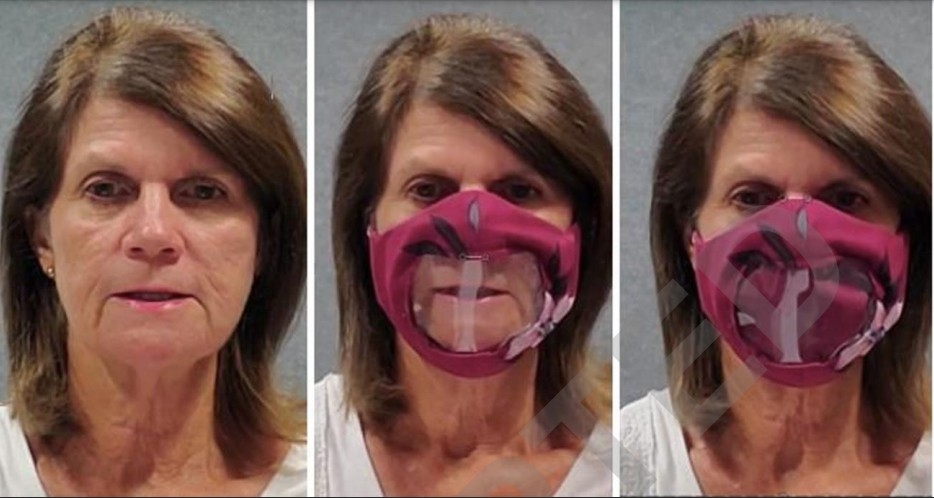

An online study involving 154 volunteers measured the importance of visual cues to communication for people with normal hearing and hearing loss (image: Linda M. Thibodeau et al./Ear and Hearing)
An online study involving 154 volunteers measured the importance of visual cues to communication for people with normal hearing and hearing loss.
An online study involving 154 volunteers measured the importance of visual cues to communication for people with normal hearing and hearing loss.

An online study involving 154 volunteers measured the importance of visual cues to communication for people with normal hearing and hearing loss (image: Linda M. Thibodeau et al./Ear and Hearing)
By Karina Toledo | Agência FAPESP – The use of transparent masks during communication increases comprehension of speech by about 10% for people with hearing loss and people with normal hearing, according to a study published in the journal Ear and Hearing.
The study was conducted at the University of Texas in Dallas (USA), with the participation of Regina Tangerino, a professor at the University of São Paulo’s Bauru Dental School (FOB-USP) in Brazil, and with support from FAPESP.
“Our findings show that wearing a transparent mask can facilitate communication for everyone, minimizing stress and improving interaction. Protection obviously has to be the primary concern, and no clear models with proven effectiveness are sold in Brazil right now,” Tangerino told Agência FAPESP.
In the US, she explained, two models of mask with a see-through portion in the mouth area have been approved by the Food and Drug Administration (FDA) and Centers for Disease Control and Prevention (CDC). “One of our aims is calling attention to the importance of the topic,” she said.
The study began early in the pandemic, in 2020, when the group posted on the internet a set of videos lasting 40 minutes, with Tangerino voicing several utterances against background noise without a mask, wearing a mask with a clear mouth panel, and wearing an opaque fabric mask. The study used 154 volunteers recruited via social media or by email. They were divided into three groups based on whether they had normal hearing, or confirmed or suspected hearing loss (with or without cochlear implants or hearing aids). They were invited to watch the videos in a quiet place and to type what they understood after each sentence. They also had to rate their level of confidence in responding and how intensely they had to concentrate to understand what was said. Each volunteer’s score was computed at the end.
On average, the volunteers in all three groups correctly understood 83.8% of the sentences spoken without a mask, 68.9% of utterances with a see-through mask, and 58.9% with an opaque mask.
“The difference of 10 percentage points [between the latter two averages] is statistically significant. This benefit applies to more than just comprehension: the participants also felt more self-confident and were able to follow what was said with less effort when the see-through mask was used,” Tangerino said. “In another study, conducted in the UK with 460 participants, the researchers noted that opaque masks influenced fatigue, anxiety and emotions in both listeners and speakers.”
Visual cues
To find out if the difference in comprehension between transparent and opaque masks was due to visual cues such as lip reading, acoustic differences between the recordings, or the tendency for some masks to muffle sound, a follow-up study using audio only was conducted with 29 volunteers, who were not told which sentences were recorded with or without a mask.
“In this case, the average performance was actually worse for sentences spoken with a clear mask than with an opaque mask, confirming the significance of visual cues in the first study. They helped listeners surmount the problem of muffled sound when a mask is worn,” Tangerino said.
Production of transparent masks certified by ANVISA, the national health surveillance agency, should be stimulated in Brazil, she added. Currently, the only see-through type available is a vinyl mask, considered insufficiently effective to block transmission of the novel coronavirus.
The article “Communicating during COVID-19: the effect of transparent masks for speech recognition in noise” can be retrieved from: journals.lww.com/ear-hearing/Abstract/9000/Communicating_During_COVID_19__The_Effect_of.98518.aspx.
Republish
The Agency FAPESP licenses news via Creative Commons (CC-BY-NC-ND) so that they can be republished free of charge and in a simple way by other digital or printed vehicles. Agência FAPESP must be credited as the source of the content being republished and the name of the reporter (if any) must be attributed. Using the HMTL button below allows compliance with these rules, detailed in Digital Republishing Policy FAPESP.





